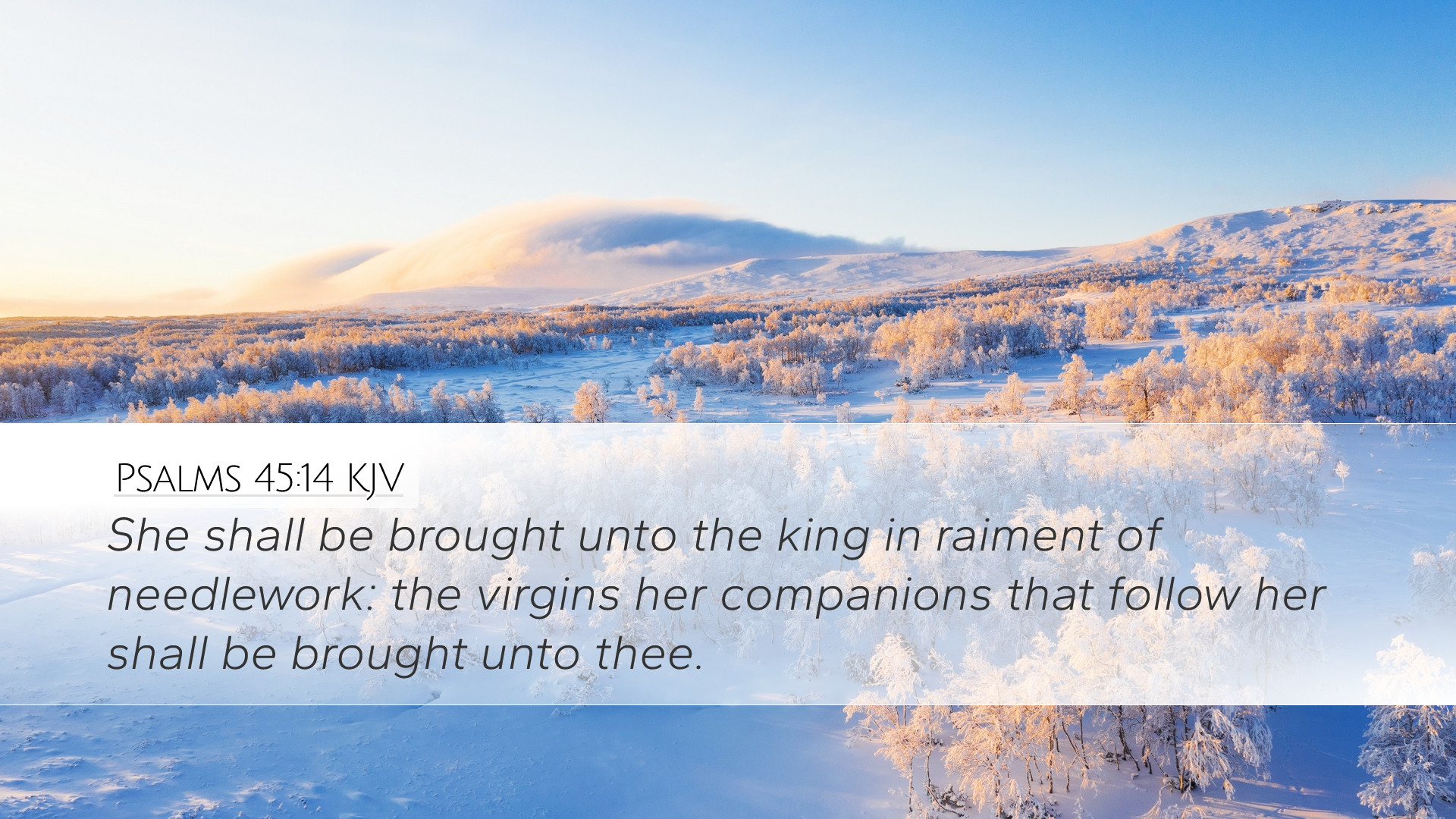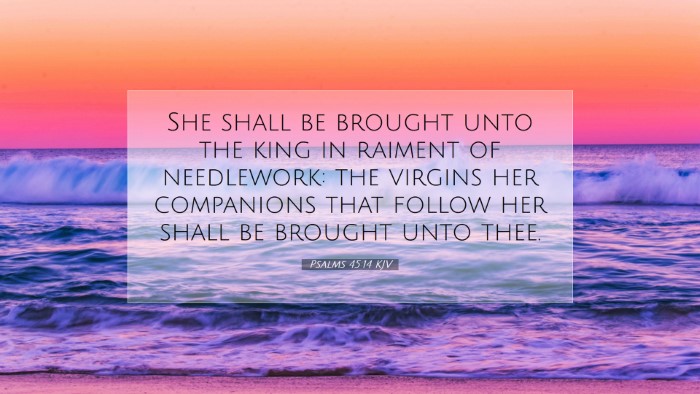Psalms 45:14 Commentary
Text of Psalms 45:14 (KJV): "She shall be brought unto the king in raiment of needlework: the virgins her companions that follow her shall be brought unto thee."
Introduction
The verse from Psalms 45:14 presents rich imagery that has been the subject of numerous theological interpretations. In this context, we will explore the significance of the 'virgin' imagery and the 'raiment of needlework' as well as the broader implications for understanding royalty, virtue, and divine favor.
Commentary Overview
Several public domain commentaries provide insights into the depths of this verse:
- Matthew Henry: Focuses on the royal nuptial theme, signifying purity and righteousness.
- Albert Barnes: Emphasizes the adornment of the Church, symbolizing her approach to Christ.
- Adam Clarke: Analyzes the cultural and historical context of royal weddings in ancient Israel.
Matthew Henry’s Commentary
Matthew Henry writes extensively on the imagery of the bride in this psalm, noting that the choice of 'needles and work' signifies delicacy, craftsmanship, and dignity. He observes:
“The bride of the king is arrayed splendidly, which signifies her high calling and the grace with which she is endowed.”
Henry interprets the verse as indicative of the Church’s preparation to meet Christ, her King. The 'virgins her companions' symbolize the purity and devotion of those who follow Christ. This passage, therefore, can be seen not only as a wedding celebration but as illustrative of the eternal relationship between Christ and the Church.
Albert Barnes’ Insights
Albert Barnes provides a detailed approach to the symbolism present in this verse. He notes:
“The needlework represents the attention to detail and the beauty that every believer should strive for as they prepare themselves for the return of Christ.”
In this context, Barnes interprets 'the virgins her companions' as those who remain faithful and pure in their lives, awaiting the return of their King. He argues that just as a bride adorns herself for her groom, believers are called to live in holiness and service, presenting themselves as a beautiful offering unto the Lord.
Adam Clarke’s Analysis
Adam Clarke points to the cultural implications of royal weddings in ancient times, where a bride's preparation would be significant for her acceptance into the royal household. He explains:
“In those days, the garments were often ornate and elaborate, indicating not only status but the value placed on the union.”
Clarke’s focus on the socio-historical context enriches the understanding of the verse by associating the 'raiment of needlework' with the expectation of excellence and the honor bestowed upon the marriage covenant. This brings forth a theological implication about how God values His people and the relationship He desires with them.
Theological Implications
The themes in Psalms 45:14 resonate with larger theological themes found throughout the Scriptures:
- Holiness and Purity: The image of virgins reflects a call to believers to live lives set apart for God.
- Divine Favor: The attire symbolizes divine acceptance and grace granted to those who follow God.
- Royalty and Identity: The bride, as a figure of the Church, reflects the identity of believers as children of the King.
Application for Believers
As believers reflect on Psalms 45:14, they are invited to consider:
- Preparation for Christ: Just as a bride prepares to meet her groom, believers should prepare their hearts and lives for the return of Christ.
- Value of Community: The companions symbolize the importance of fellowship among believers, encouraging one another in faith as they await Christ’s return.
- Excellence in Conduct: The detailed craftsmanship of the raiment serves as a reminder for believers to pursue excellence in their spiritual walk.
Conclusion
Psalms 45:14 presents a vivid picture of beauty, commitment, and divine favor. In understanding this verse through the lenses of Matthew Henry, Albert Barnes, and Adam Clarke, one can appreciate the multi-faceted dimensions of the imagery presented. This serves not just as a historical account but as a theological treasure that underscores the importance of purity, preparation, and the joy of being in communion with the King.


